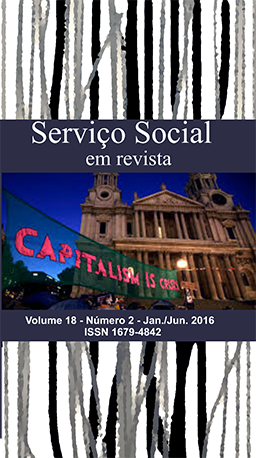Capacita SUAS in Pará: an approach from the territorial diversity
DOI:
https://doi.org/10.5433/1679-4842.2016v18n2p210Keywords:
SUAS. Continuing education. Territory. Public policy. DiversityAbstract
The purpose of this paper is to discuss the particularities of the state of Pará concerning the actualization of SUAS (Unified Social Work System), from its territoriality and the social vulnerabilities to which it is exposed. Such discussion is narrated from the experience of Capacita SUAS Program in Belem do Pará, Castanhal, Marabá and Altamira towns. The training took place from May to August 2014, in order to meet the objectives of the "SUAS National Training Program", whose aims are, among other, to ensure permanent education to qualify its professionals. The results of the Capacita SUAS Program as a Continuing Education strategy are positive, considering the importance of giving information and qualification to its employees, as well as of carrying out and ensuring what is posed by NOB/HR. This research was produce from documental analysis and through data gathering during the trainings. Students registered the classes and the debates carried out, what allowed the writing of this article. This valuable experience disclosed to us, as Capacita SUAS facilitators, the need for continuity of the Program as a Continuing Education strategy, which allows workers' knowledge enhancementDownloads
Downloads
Published
How to Cite
Issue
Section
License
Copyright (c) 2016 Serviço Social em Revista

This work is licensed under a Creative Commons Attribution-NonCommercial-NoDerivatives 4.0 International License.
A revista se reserva o direito de efetuar, nos originais, alterações de ordem normativa, ortográfica e gramatical, com vistas a manter o padrão culto da língua e a credibilidade do veículo. Respeitará, no entanto, o estilo de escrever dos autores. Alterações, correções ou sugestões de ordem conceitual serão encaminhadas aos autores, quando necessário. Nesses casos, os artigos, depois de adequados, deverão ser submetidos a nova apreciação. As provas finais não serão encaminhadas aos autores. Os trabalhos publicados passam a ser propriedade da revista Serviço Social em Revista, ficando sua reimpressão total ou parcial sujeita a autorização expressa da revista. Em todas as citações posteriores, deverá ser consignada a fonte original de publicação, no caso a Serviço Social em Revista. As opiniões emitidas pelos autores dos artigos são de sua exclusiva responsabilidade.















